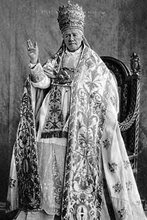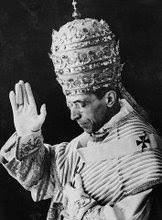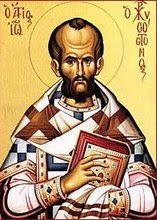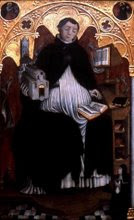Communion of Saints:
St. Robert Bellarmine on the Mystical Body of Christ
by Fr. John A. Hardon, S.J.
Shortly after his defection from Rome, Johann Döllinger bitterly reproached the First Vatican Council with “doing nothing but defining the private opinions of a single man—Cardinal Robert Bellarmine.” The accusation is false but suggestive, because it leads us to investigate the teaching of St. Robert on the organization of the Catholic Church as the Mystical Body of Christ. Most of the Council’s business had to deal with the origin and nature of the one true Church. Moreover, Bellarmine’s ecclesiology was the main source from which the Fathers of the Council drew their decrees and definitions. Consequently, with the current interest even among non-Catholics in the Church of Christ as the Mystical Body, we should not overlook what St. Robert Bellarmine has to say about a subject in which the Church herself considers him the outstanding authority.
--------------------------------------------------------------------------------
Pope Pius XII, in his Encyclical Mystici Corporis, confirms this authority when he quotes St. Robert to support his explanation of why the social Body of the Church should be honored with the name of Christ. “As Bellarmine notes with acumen and accuracy,” the Pope says, “this naming of the Body of Christ is not to be explained solely by the fact that Christ must be called the Head of His Mystical Body, but also by the fact that He so sustains the Church, and so in a sense lives in the Church, that it is, as it were, another Christ.” 1 So much for an apologetic of Bellarmine’s qualifications. What follows is a synthesis of his doctrine on the Mystical Body taken from his sermons and controversies, which, it is hoped, will help to amplify several points of detail which the Mystici Corporis only suggests but otherwise does not develop or dwell upon.
The Mystical Body of Christ Is the Catholic Church
It is significant that Bellarmine went out of his way to emphasize what seems so obvious to us—that the Mystical Body of Christ is also the established Church of Christ. Until his time, there were relatively few Christians not in communion with Rome who claimed that their organization was the Body of Christ of which St. Paul wrote to the Corinthians: “You are the Body of Christ, member for member” (I Cor., xii. 27). But with the advent of Luther and Calvin the situation changed. On the one hand, they preached an invisible Church founded on faith and predestination; on the other hand, they called their Church the Body of Christ. This was a new idea and challenge to traditional Catholic theology.
The Mystical Body of Christ, the predestinarians argued, is not unlike His tangible physical Body. And since the whole physical Body of Christ is in heaven and glorified with all its component parts, it follows that the Mystical Body should also arrive at heavenly glory in all its individual members. The statement looks harmless enough until we examine its implications. If every member of the Mystical Body is going to be saved and the Church of Christ is the Body, then the only members of the Church are those whom God has eternally decreed should enter heaven. Everyone else is a putative member only, deceived by God and deceiving himself that he is even a Christian, much less a part of the Mystical Body.
“My first reaction to this doctrine,” Bellarmine observes, “is that the opposition has pushed the analogy between the mystical and physical Bodies of Christ far beyond the limits ever intended for them by the Apostle. They are certainly alive in general outline, but not in every detail. And besides, even the physical Body of Christ entered heaven and was glorified only in its formal constituents, but not in all its natural parts, many of which were lost and changed with the passage of time, as we notice happens in our own bodies. So, it is correct enough to say that the whole Mystical Body will be saved in its constitutive elements, inasmuch as every class in the Catholic Church—apostles, prophets, teachers, confessors and virgins—will be represented among the saved. It is not true, however, that all its material elements, that is, every numerical member of the Mystical Body, will finally attain to salvation.” 2
Calvinists and The Mystical Body
Another argument, of the Calvinists particularly, was that the only Church of which Christ may be said to be the Head is the one which He will eventually save and “set before Him on the Day of Judgment—glorious and without spot or wrinkle,” as described by the Apostle in his Epistle to the Ephesians. However, since only the predestined will be saved and glorified, only they are properly to be considered members of the Church of Christ.
St. Robert answers: “It all depends on how you understand the expression, ‘His Church.’ If it is taken to mean that Christ is Head only of that part of ‘His Church’ which He will save, then the proposition is false. Christ is Head of the whole Mystical Body, in spite of the tragic fact that certain people who are now its members, will be lost for all eternity. But if ‘His Church’ is understood to include the whole body of the faithful as distinguished from the societies of unbelievers, then the proposition is true, while the conclusion deduced from it is false. For although some members of this Church will not be saved, it is wrong to conclude that therefore Christ does not save His Church, of which He is the Head.” 3
However, Bellarmine does not limit his concept of the Mystical Body to the visible Church on earth. The Mystical Body of Christ is composed of three “Churches”—the Church Militant, the Church Suffering and the Church Triumphant. He has as little sympathy with those who denied membership in the Body of Christ to the souls in purgatory and the Saints in heaven, as he had with anyone who restricted its membership to the predestined and elect or extended it to those who were united only by a common, internal faith in Christ.
Bellarmine Defends Honoring the Saints
In his defense of the Holy Eucharist against the Calvinists, St. Robert had to answer some of their stock charges on the traditional custom of offering the Holy Sacrifice in honor of the Saints. He explains that the Protestant bias against this practice arises form two fundamental errors in their theology: one a misunderstanding of Catholic doctrine, where they claim that we offer the Mass as an act of adoration to the Saints instead of to God; the other is an unwarranted limitation of membership in the Mystical Body. “The practice of offering Holy Mass to honor the Saints,” he says, “is especially appropriate as a public expression of our belief in the Communion of Saints. The Sacrifice of the physical Body of Christ is an oblation of the corporate Mystical Body of Christ. Moreover, since we do not hesitate to mention the names of living persons, such as the Pope and bishop, in the ritual of the Mass, why should we fail to remember those of the faithful departed who are in heaven or in purgatory, when all of them belong to the same Body of the Lord? According to St. Augustine, there is no better way of fulfilling the one great purpose for which the Eucharistic Sacrifice was instituted, than that it might symbolize the universal sacrifice in which the whole Mystical Body of Christ —the whole regenerated City of God—is offered by the hands of the great High Priest to the glory of His Heavenly Father. Once we recognize the Saints, no less than we, are organically united to the Mystical Body, it becomes not only proper but necessary that their memory should be recalled during the Holy Sacrifice of the Mass.” 4
Membership in The Mystical Body
In general, however, when Bellarmine speaks of the Mystical Body, he has in mind only the first of its three branches, the Church Militant—or, in other words, the visible organization of the Roman Catholic Church. Thus, in treating the delicate question of occult infidels, he refutes the doctrine of Calvin who held that, if a baptized person has lost the virtue of faith, in spite of his external profession of belief and conformity with Christian practice he is no longer a member of the organic Body of Christ. “It is certainly true,” he admits, “that a sincere faith and not its mere external profession is required if we are to be internally united to the Body of Christ, which is the Church …. But even the man who makes only an outward profession along with the rest of the faithful is a true member, albeit a dry and dead member, of the Body of the Church.” 5 It follows, therefore, that the Mystical Body of Christ is the Roman Catholic Church, whose members are all those who have been baptized and who at least externally practice and profess the true faith. Commentators on the Mystici Corporis make special note of the fact that, after centuries of controversy on the subject, the Pope has authoritatively approved Bellarmine’s doctrine on the minimum essentials for membership in the Mystical Body—which reads like a paraphrase from the third book of St. Robert’s De Conciliis. In the words of Pope Pius XII, “only those are really to be included as members of the Church who have been baptized and profess the true faith and have not unhappily withdrawn from Body-unity, or for grave faults been excluded by legitimate authority. For in one Spirit were we all baptized into one Body.” 6
Sinners as Members of The Mystical Body
John Wyclif, and after him the Protestants in general, allowed that all the justified in the state of grace, and only they, are members of the Mystical Body. Even Catholic theologians like de Soto and Cano, when they came to explain how sinners are members of the Body of Christ, gave them analogous membership and nothing more. They admitted that baptized persons in the state of sin may be called “the faithful” and “Christians,” but only in the sense that they are somehow externally attached to the Body of the Church. “Not only the organs and limbs,” they argued, “but also bodily secretions, the teeth, the hair, and such like, all belong to the body.” Bellarmine refused to accept this view. “If what they say is true, the consequences are impossible. A wicked Pope then is not the Head of the Church, and other bishops, if they are in sin, are also not heads of their respective churches. For the head is not a bodily secretion or the hair, but a member of the body—indeed, its most important member.”
“To solve the difficulty, therefore, we have to distinguish two senses in which a member of the body may be understood. It may be taken in the strict sense to designate the member in itself, in its essence and substance as a member. Or it may mean a member of the body in its capacity as a medium of activity through which the body operates. Thus, for example, the eye of a man and the eye of a horse are specifically different as substances or entities because they are radicated specially different souls. But as kinetic instruments they are specifically the same because both have the same end and object of their operation—both being directed to the sensible perception of color.
“An evil bishop, a bad priest, a layman in grievous sin are dead members of the Body of Christ, and therefore not true members, if we understand ‘member’ in the strict sense of an integral part of a living body. However, these same ‘dead members’ are very vital members if we consider them as instruments of activity within the Church. So that the Pope and bishops are real heads, the teachers and preachers are real eyes and tongues of the Body of Christ, even when they have fallen from the grace of God. For while it is true that a Christian becomes a living member of this Body through charity, yet in the Providence of God the instruments of operation in the Church are constituted by the power of orders and jurisdiction, which can be obtained and exercised even by a man who is personally an enemy of God.
“Hence the great difference between a physical body, in which a dead member cannot serve as a vital instrument, and the supernatural Mystical Body, where this is not only possible but actually happens. To explain the paradox we should recall that in natural bodies their work depends entirely on the health and soundness of the organs by which they act. But the Mystical Body of Christ can operate independently of the virtue and vitality of its members, because the soul of this Body, which is the Holy Spirit, can function equally through good instruments as through bad, through instruments that are alive as through those which are dead.” 7
The Functions and Parts of The Mystical Body
For seven years, starting in 1568, Bellarmine taught theology at Louvain, where he met and successfully routed Michael de Bay, father of Baianism and author of the pernicious theory that man can live the life of friendship with God even before Baptism and without the remission of sins. During this time he also preached every week at the Cathedral to a mixed congregation of Catholics and non-Catholics, some of whom came all the way from Elizabethan England just to hear him speak. About a hundred of these discourses have come down to us, among them a panegyric on Our Lady, given on the Feast of her Nativity, in which the Saint recalled that this was the anniversary of another sermon preached not far away by Martin Luther, when he blasphemously attacked the sanctity of the Mother of God, telling his audience that: “She has no more intercessory power with God than you or I, because she is no more holy than we.”
Bellarmine launched into what perhaps the most bitter attack on any opponent that can be found in all his extant writings. Best of all, though, is the occasion which this defense of Mary’s sanctity gave him to reveal her transcendent position in the Mystical Body of her Divine Son.
“The Church,” he explains, “is a most beautifully organized and stately Body of which Christ, the God-man, is the Head. ‘For the Lord hath made Him Head over all the Church,’ as the Apostle says. What is the Head? It is the principle and governing force of the Body. Christ is, therefore, the Head because, as He tells us, ‘I am the principle who speak with you.’ In what way is the head superior to the other members of the body? In this that, while the rest of the body is possessed of only one bodily sense and that the most ignoble, the head is gifted with all the senses, including the sense of touch. Christ is, therefore, the Head in whom are the eyes of His providence, by which He watches over us; the ears of His mercy, by which He listens to our prayers; the nostrils of His justice, by which after death He will separate the good from the wicked and who have lived among us; and the palate of experience, by which He tries the virtue and fidelity of the least and the greatest of us.
‘What is the special function of the head? To give sense and movement to the other members. So, Christ is the Head because He freely gives life and movement, that is faith and charity, and all the virtues, to the faithful members who compose His Body. And although at times and to a limited degree He permits, or rather commits, to mere man the function of certain senses (like the sense of sight to teachers, of speech to preachers, of sight and smell and hearing to pastors), yet He always reserves to Himself the faculty of giving life and motion, which is the special prerogative of the head of every body.” 8
The Holy Spirit in The Mystical Body
Anticipating by three centuries the doctrine of the Mystici Corporis in which Pope Pius XII attributes to the Holy Spirit the invisible principle of life in the Mystical Body, Bellarmine declares: “The Heart, which is in the center of the Body, and which, although itself unseen, mysteriously nourishes the parts that are seen, is the Holy Ghost. For He is not clothed with human flesh and thus made visible, like the Head, who is Christ our Lord. They rant, therefore, who madly assert that Melchisedech or one of the prophets is the Holy Spirit. No, the Spirit of Christ is not visible to human eyes, and yet it is He who governs and feeds and keeps alive the Body of Christ, which is the Catholic Church.” 9
Bellarmine lived in the period of horrible transition from orthodoxy to heresy, when Calvin was teaching the people that there is no priesthood and no hierarchy, when Luther was calling the Pope “Antichrist” and bishops and priests “destroyers of human souls.” But if the Church which Christ established is His Body, this Body must have shoulders, and these shoulders, according to Bellarmine, are the Apostles, and the Roman Pontiffs, bishops and priests who have succeeded them. “We are accustomed to placing burdens on our shoulders,” he writes, “and so also Christ has done, by placing the burden of the Church’s government on the shoulders of the Apostles and their priestly successors. It follows, therefore, as the Fathers of the Church keep reminding us, that the episcopal office is not so much a dignity as a heavy responsibility. Hence also, the Supreme Pastor of souls, on whom rests the heaviest burden of all, appropriately calls himself the servant of the servants of God.” 10
There are two sorts of enemies with whom the Church has had to contend in the course of her history: pagans and infidels from without, and heretics from within her ranks. Against both of these Christ has endowed His Mystical Body with adequate means of defense. Bellarmine conceives the martyrs and teachers of the Catholic Church as the arms of the Mystical Body. “What are the martyrs,” he asks, “but the arms of the Body of Christ—men and women who fight with the sword of God’s word and conquer the enemies of His name by the shedding of their blood? And not only the martyrs but the teachers of Christ’s doctrine are the arms of His Body. Both are equally necessary to combat the forces of evil that are aligned against the Church. Pagans and the spirit of idolatry are met and defeated by the martyrs; heretics and apostates by the teachers. If the most painful kind of death is martyrdom, the most dangerous kind of life is to teach the truth. To both has Christ promised the reward of victory, not only in heaven, but over their enemies even here on earth.” 11
Protestant Assaults on The Practice of Celibacy
An unfamiliar side of the Protestant revolt was the disgraceful way in which the self-appointed reformers of the Church’s morals allied themselves against her doctrine and practice of celibacy. In a rhetorical passage of his “Babylonian Captivity,” Luther pleaded with “the prisoners of the monastic life” to break the chains which bound them to their monasteries and to serve Christ with the untrammeled liberty of the children of God. If any of them still hesitated to accept the responsibilities of marriage, he argued, let them remember that this is only a ruse of the devil who would have them reverse the order of divine providence and obey man rather than God.
Against this background it is easier for us to sympathize with the strong feeling to which Bellarmine would give expression whenever he wrote on the subject of virginity. “Virgins,” he believes, “are the vitals of the Mystical Body, comparably close to God as the vitals of a physical body are close to the human heart. If only the swillers, gluttons and lechers among the heretics understood how pleasing is virginity in the eyes of God, how ‘they follow the Lamb wherever He goes, singing a new song before the throne which no one else can sing’ (Apoc., xiv. 3, 4)! If only they would read the promise which the Lord had spoken through the prophet Isaias: ‘Let not the eunuch say: “behold I am a dry tree.” For thus saith the Lord to the eunuchs; ‘I will give to them in My house and within My walls a place and a name better than sons and daughters. I will give them an everlasting name which shall never perish’ (Is, lvi. 3, 4). But the enemies of the Church will not read and will not understand. If only they realized that, by forcing consecrated virgins to marry, they are tearing at the very entrails of the Mystical Body and robbing it of its dearest possession. If only they realized this, I say, they would not so readily debauch the minds of the young with their devilish doctrine about the unchristian character of celibacy.” 12
Mary’s Place in The Mystical Body
In a way, the most inspiring feature of Bellarmine’s theology of the Mystical Body is the place which he assigns within it to the Blessed Mother of God: “The Head of the Catholic Church is Jesus Christ, and Mary is the neck which joins the Head to its Body.” Because she has merited so well of God by her perfect conformity to His holy will, He has decreed that “all the gifts and all the graces which proceed from Christ as the Head should pass through Mary to the Body of the Church. Even the physical body has several members in its other parts—hands, shoulders, arms and feet—but only one head and one neck. So also the Church has many apostles, martyrs, confessors and virgins, but only one Head, the Son of God, and one bond between the Head and members, the Mother of God. By virtue of her transcendent merits before God, the Blessed Virgin stands closer than any other creature to the Head of the Mystical Body; it is no exaggeration to say that she unites the Head to the Body, and that therefore through her, before all others, flow the heavenly blessings from the Head, who is Christ, to us who are His members.” 13
The doctrine of the Mystical Body is anything but sterile theology. Among the practical consequences which St. Robert derives from our incorporation in Christ is the motive which it gives for the practice of fraternal charity. The Saints in heaven intercede for the souls in purgatory, he says, because they are both members of the same Body. The souls in purgatory intercede for each other because they are also members of one Body; the Saints and poor souls intercede for us because we are one Body with them, member of member; and we are moved to pray for each other on earth, to ask for favors from the Saints in heaven, and to pray for the souls in purgatory because “together with them we form one Church and one Body, united by the bond of the same charity in the Kingdom of Christ.” 14
--------------------------------------------------------------------------------
End notes
Mystici Corporis,English Translation (American Press, 1943), p. 24.
De Ecclesia Militante, lib. III, cap. 7.
Ibid
De Eucharistia, lib. VI, cap. 8.
De Conciliis, lib. III, cap. 10.
Mystici Corporis, p. 12.
De Ecclesia Militante, lib. III, cap. 7.
Concio xlii de Nativitate B.V.M.
Ibid
Ibid
Ibid
Ibid
Ibid
Wednesday, February 15, 2012
Subscribe to:
Posts (Atom)



















